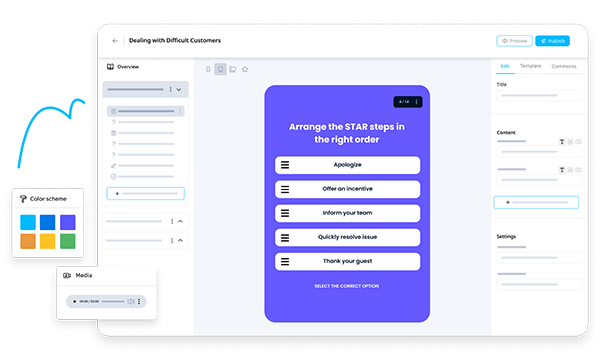5 Blended Learning Models

Blended learning is the term used to describe when traditional teaching methods are enriched with the application of technology. It’s important that your organization utilize these methods to train employees as they have many learning benefits, which means a more competent workforce. Here, we’ll dive deeper into the five most common blended learning models.
Blended Learning Model #1 - Station Rotation Model
With the station rotation model, instructors can transform traditional theory-based classrooms into amazing workshops. This can be done by incorporating workstations like e-learning, group activities, and so on. During each class, your employees will rotate through various modules, for example, online learning modules, group project modules, and face-to-face or one-on-one instructional modules.

A typical example of how this would work is: a learner completes an online assignment, then goes on to participate in a group activity linked to the project, and then finally engages with an instructor for a one-on-one discussion about the task.
This model of blended learning has multiple benefits, including:
- Personalized learning experiences
- Multiple learning methods, which improve knowledge retention
- Collaborative learning
An essential aspect of setting up a Station Rotation Model for training your employees is an online interface. Use EdApp, the world's number one micro-learning platform, to create engaging, well-designed, interactive online courses. With this platform, it’s not difficult, time-consuming, or expensive to incorporate online lessons into your training workshops.

Join EdApp for free and start implementing different blended learning models into your training!
Blended Learning Model #2 - Flex Model
The flex model is a blended learning method that allows your learners to interact with both online components and training instructors during the same session. This type of blended learning model is usually done in a classroom setting computer lab that has enough computers for all learners.

Flex models can either be both synchronous or asynchronous. Learners do online components of the course on the computers while the trainers stay in the room. This allows them the opportunity to ask for clarification or direction easily.
Flex models give learners the ability to control the pace at which they proceed through a course. Learners are allowed to work independently on every topic. This type of blended learning is particularly useful for training materials centered around technology.
To effectively create a Flex model for your employees to train, you will need to follow their progress closely. Use EdApp, to not only create online courses for the Flex model but take advantage of its reporting system that allows you to monitor the progress of each learner keenly.
Blended Learning Model #3 - Flipped Classroom Model
The flipped classroom model is one that “flips” how traditional lessons are taught. The typical training session is usually done with the theory being taught in the classroom, and students then try to practice and apply the knowledge as homework.

In this blended learning model, it is the opposite. Material is introduced to the students in the form of videos and lectures, all online. The student has the flexibility to access the material whenever the time is convenient for them and work at it at their own pace. The knowledge your learners gain from these online interactions is then practiced and applied in the classroom via group work, discussions, and problem-solving exercises.
There are many advantages to this type of learning model, such as:
- Learners will be more confident to participate during classroom training because they gained an understanding of the material before the class
- Learners can proceed at their own pace and visit the content as often as they need to
- It makes learning more effective because of the fun factor introduced through hands-on group activities
A lot of trainers don't like the flipped classroom model because there is an increased demand for them to create videos and other online learning content for their students to go through. EdApp is a great solution for this. With EdApp, trainers can easily utilize the Creator Tool or the PowerPoint Converter to quickly create media-enriched micro lessons that their students can easily follow.

Blended Learning Model #4 - Online Lab Model
The online lab model of blended learning is one that involves learners attending a classroom that is set up for the complete course to be delivered online. In this model, there are no teachers available to the students, but there are professionals who supervise their class activities.

Compared to other blended learning examples, this type of blended learning is an excellent way for organizations to save money on staffing while offering their learners a greater selection of courses to learn from. It is especially useful for remote learners who need a flexible course option that allows them to study at their own pace. If your organization cannot accommodate all the trainees in a class at the same time, the online lab model is a wonderful option.
Blended Learning Model #5 - Online Driver Model
This model utilizes technology the most. The Online Driver model pretty much completely pushes aside traditional teaching methods in favor of technology. Primarily, students utilize online resources to receive the class material and communicate with their teachers.

There are a few instances in which some face-to-face teaching is incorporated into the model, but it is not common. There are two types of teaching components utilized in the online driver model. The first is synchronous teaching, which means most or all of the teaching content is delivered by a teacher over a live streaming platform, such as Zoom. This entirely virtual classroom is similar to traditional classrooms that utilize teacher-led education.
The second teaching component is asynchronous learning, where the course materials are delivered through e-courses, journals, videos, and so on. Students are allowed to go through the material anytime they wish to and collaborate with other students via message boards, messaging apps, and so on.
The EddApp micro-learning platform is uniquely designed to facilitate the Online Driver model for large and small organizations. The platform makes it easier for training materials to be created or converted into an online delivery method that students can access at any time. Trainers are able to assess and monitor students’ grasp of the material through a quiz maker and an analytics suite.

Conclusion
In conclusion, blended learning techniques are capable of maximizing learning by incorporating technology into traditional learning solutions. You’ll need a blended learning LMS to create and manage the e-learning aspect of blended learning. EdApp is the most cost-effective, time-efficient, adaptable, and engaging platform on the market.
Author
Guest Author Gavoy Small
Gavoy Small is a guest author at SC Training (formerly EdApp) who specializes in ESL Teaching, Content Production, and Customer Service.
